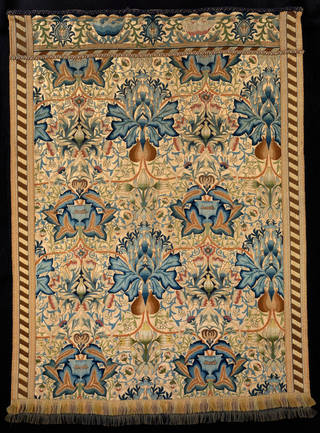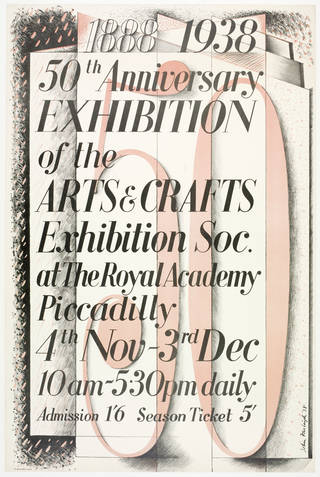What Is the Difference Between the Arts and Crafts Movement and the Wiener Werkstãƒâ¤tte?
Arts and crafts: an introduction
The nativity of the Arts and crafts movement in Britain in the late 19th century marked the commencement of a change in the value society placed on how things were made. This was a reaction to not only the dissentious effects of industrialisation just also the relatively low status of the decorative arts. Arts and crafts reformed the design and industry of everything from buildings to jewellery.
Fine art is that in which the mitt, the head, and the centre of man become together.
John Ruskin, 'The Cestus of Aglaia, the Queen of the Air', 1870
In Britain the damaging effects of automobile-dominated product on both social conditions and the quality of manufactured goods had been recognised since around 1840. But it was not until the 1860s and '70s that new approaches in compages and design were championed in an attempt to right the problem. The Craft movement in Britain was born out of an increasing understanding that society needed to adopt a different set of priorities in relation to the manufacture of objects. Its leaders wanted to develop products that not only had more than integrity but which were likewise fabricated in a less dehumanising way.
Structured more than by a set of ideals than a prescriptive style, the Movement took its proper noun from the Arts and Crafts Exhibition Order, a group founded in London in 1887 that had as its first president the creative person and volume illustrator Walter Crane. The Gild's main aim was to assert a new public relevance for the piece of work of decorative artists (historically they had been given far less exposure than the work of painters and sculptors). The Great Exhibition of 1851 and a few spaces such as the Refreshment Rooms of the S Kensington Museum (later known as the V&A) in the 1860s had given decorative artists the chance to show their work publicly, but without a regular showcase they were struggling to exert influence and to reach potential customers.

The Arts and Crafts Exhibition Order mounted its first annual exhibition in 1888, showing examples of work information technology hoped would help raise both the social and intellectual status of crafts including ceramics, textiles, metalwork and article of furniture. Its members publicly rejected the excessive ornament and ignorance of materials, which many objects in the Great Exhibition of 1851 had been criticised for. For many years in Britain exhibitions mounted by the Society were the only public platform for the decorative arts, and were critical in changing the way people looked at manufactured objects.

Although it was known by a unmarried name (one that wasn't in fact used widely until the early 20th century), the Arts and Crafts motion was in fact comprised of a number of different artistic societies, such every bit the Exhibition Lodge, the Arts Workers Guild (prepare in 1884), and other craftspeople in both pocket-size workshops and large manufacturing companies.
Many of the people who became involved in the Motility were influenced by the piece of work of the designer William Morris, who by the 1880s had go an internationally renowned and commercially successful designer and manufacturer.

Morris merely became actively involved with the Arts and Crafts Exhibition Society a number of years after information technology was set up (between 1891 and his death in 1896), simply his ideas were hugely influential to the generation of decorative artists whose piece of work information technology helped publicise. Morris believed passionately in the importance of creating beautiful, well-made objects that could be used in everyday life, and that were produced in a style that allowed their makers to remain connected both with their production and with other people. Looking to the past, particularly the medieval period, for simpler and better models for both living and production, Morris argued for the return to a system of manufacture based on minor-scale workshops.

Morris was not entirely against the utilize of machines, but felt that the sectionalization of labour – a organisation designed to increase efficiency, in which the manufacture of an object was broken into small, separate tasks, meaning individuals had a very weak relationship with the results of their labour – was a move in the wrong direction.
Like many idealistic, educated men of his era, he was shocked by the social and environmental impact of the factory-based arrangement of product that Victorian Britain had so energetically embraced. He wanted to free the working classes from the frustration of a working day focused solely on repetitive tasks, and let them the pleasure of craft-based product in which they would engage straight with the creative procedure from beginning to cease.
Morris was himself inspired by the ideas of the Victorian era'due south leading fine art critic John Ruskin (1819–1900), whose piece of work had suggested a link betwixt a nation'south social health and the manner in which its appurtenances were produced. Ruskin argued that separating the act of designing from the deed of making was both socially and aesthetically damaging. The Arts and Crafts motion was also influenced by the work of Augustus Pugin (1812–1852). An interior designer and architect, Pugin was a Gothic revivalist and a member of the Design Reform Motion. He had helped claiming the mid-Victorian mode for ornamentation, and, like Morris, focused on the medieval catamenia as an platonic template for both good design and good living.

In the final decade of the 19th century and into the 20th, the Craft motion flourished in large cities throughout the Great britain, including London, Birmingham, Manchester, Edinburgh and Glasgow. These urban centres had the infrastructure, organisations and wealthy patrons it needed to gather footstep. Exhibition societies inspired by the original i in London helped plant the Motion's public identity and gave it a forum for give-and-take. Members of the Arts and crafts community felt driven to spread their bulletin, convinced that a better organization of pattern of manufacture could actively change people'due south lives. Between 1895 and 1905 this stiff sense of social purpose collection the creation of over a hundred organisations and guilds that centred on Craft principles in Britain.
Progressive new art schools and technical colleges in London, Glasgow and Birmingham encouraged the development of both workshops and individual makers, besides equally the revival of techniques, including enamelling, embroidery and calligraphy. Arts and Crafts designers also forged new relationships with manufacturers that enabled them to sell their goods through shops in London such as Morris & Co. (William Morris's 'all under i roof' store on Oxford Street), Heal'southward and Liberty. This commercial distribution helped the Movement'south ideas reach a much wider audience.

A particular feature of the Arts and crafts move was that a large proportion of its leading figures had trained as architects. This mutual culture helped develop a commonage belief in the importance of designing objects for a 'full' interior: a space in which architecture, furniture, wall ornament, etc. composite in a harmonious whole. As a upshot, virtually Craft designers worked beyond an unusually wide range of different disciplines. In a single career someone could use craft-based principles to the pattern of things every bit varied as armchairs and glassware. Arts and Crafts also had a significant impact on compages. Figures including Philip Webb, Edwin Lutyens, Charles Voysey and William Lethaby quietly revolutionised domestic space in buildings that referenced both regional and historical traditions.

Although the Arts and crafts movement evolved in the city, at its heart was nostalgia for rural traditions and 'the simple life', which meant that living and working in the countryside was the ideal to which many of its artists aspired. Increasingly, many left the city to plant new ways of living and working, with workshops fix across Britain in locations including the Cotswolds, the Lake District, Sussex and Cornwall. All these places offered picturesque landscapes, an existing civilisation of craft skills and, importantly, rail links for access to patrons and the London market.
Arts and Crafts makers based in rural communities both revived arts and crafts traditions and created employment for local people. This kind of development meant that the Movement endured longer in the countryside than in the urban center, and had a more than significant impact on the rural than the urban economy. Significantly, the Arts and crafts community was open up to the efforts of not-professionals, encouraging the involvement of amateurs and students through organisations such as the Home Arts and Industries Association. And it also created an surround in which, for the first fourth dimension, women equally well equally men could begin to take an active part in developing new forms of design, both every bit makers and consumers.
In Europe the honesty of expression in Craft work was a catalyst for the radical forms of Modernism, whereas in United kingdom of great britain and northern ireland the progressive impetus of the Move began to lose momentum after the First Earth War. Nether the control of older artists it had begun to withdraw from productive relationships with industry and into a purist celebration of the handmade. Some organisations sympathetic to Arts and crafts ethics did survive, specially in the countryside, and the original Arts and Crafts Exhibition Guild mounted regular shows up to and beyond its 50th anniversary in 1938. In 1960, t he Society merged with the Cambridgeshire Club of Craftsmen to form the Society of Designer Craftsmen, which is still active today.

Notice more near Arts & Crafts.



0 Response to "What Is the Difference Between the Arts and Crafts Movement and the Wiener Werkstãƒâ¤tte?"
Post a Comment